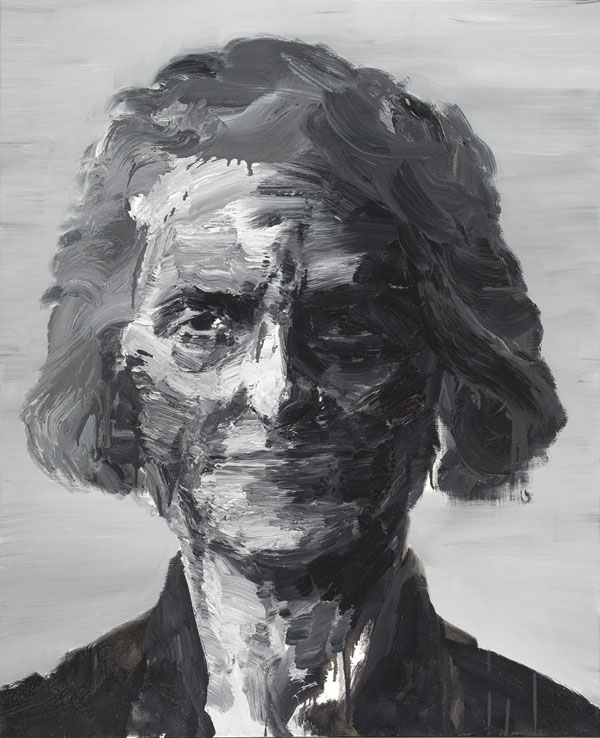Yan Pei Ming was born in a working-class family in the Zhabei district of Shanghai in 1960. During the Cultural Revolution, he painted a large number of propaganda paintings of workers, peasants, soldiers, political leaders, etc. After completing secondary school he applied to the Shanghai Art & Design School, but his application was rejected. However, this setback did not quench his desire to make art his career. At the age of 19 he traveled to France, where he hoped that his uncle (who was already living there) would be able to help him. In the event, as soon as he got off the plane he was sent to work in a factory making leather handbags. Yan subsequently moved to Dijon, in Central France, where he passed the entrance examination to begin a course of study at the Ecole Superieur des Beaux-arts de Dijon. After a period of five years in which he supported himself by working part-time, Yan graduated. He has said that "the five years which he spent studying at Dijon were the happiest of his life."
Most of the courses at the Ecole Superieur des Beaux-arts de Dijon related to art theory concepts and installation art, whereas Yan Pei Ming just wanted to paint. Yan feels that "Painting is very difficult, because the 'language' of painting is a very old one that everyone understands. Unless your work stands out from the crowd, and you have something special to say, and your own particular ideas to get across, it is very difficult to get anywhere in painting. Installation art is something conceptual; if you are crafty enough, you can get away with producing anything." Once, when an art critic asked him why he always used the same basic colors, Yan said, without any false modesty and without any self-pity regarding what he had experienced as a youth, that when he was a student, "whenever you were mixing colors, one of the teachers would always appear from nowhere to offer you advice." Demonstrating what he mockingly refers to as "Shanghainese cleverness," Yan decided that, to avoid constant interference by the teachers, and to be able to go his own way, he would stick to using the basic colors white, black, gray and red.
In 1987, benefiting from the skill in portraiture that he had developed when creating propaganda paintings during the Cultural Revolution, Yan Pei Ming began to paint large portraits of Mao Zedong's head. Due to the prevalence of socialist though in France, many of the leading figures in French politics and in the French art world had a great respect for Mao Zedong. "When I was starting out, I used the image of Mao Zedong to get across the messages I wanted to present in relation to China. This was because, when I first arrived in Franc, no-one knew who I was, but everyone knew Mao Zedong." Yan's unique expressive lexicon and the pronounced visual impact of his huge canvasses attracted the attention of the Centre Pompidou in Paris. In 1991, Yan Pei Ming held his first solo exhibition in France, entitled "My Story Begins with His History."
Following on from his portraits of Mao Zedong, the range of Yan Pei Ming's work began to expand to include not only images of political figures radiating a sense of power, but also pictures of victims and the disadvantaged. The subjects of his paintings have included people like Bernard L. Madoff, a former chairman of the NASDAQ stock exchange in the U.S. who was the key figure in the largest financial fraud in U.S. history. "There must have been plenty of people who made a lot of money through him, but we never hear anything about them. It is the one who is suffering who I am interested in. Good fortune and happiness never last."
In 2009, Yan Pei Ming became the first living contemporary artist to have his work shown at the Louvre. "When the Louvre invited me to have a solo exhibition there, my first thought was to paint the Mona Lisa; the Mona Lisa is the classic western portrait." Yan explains that attempting to reinterpret the Mona Lisa is a major challenge in the Western cultural tradition, and that many artists have attempted it. Yan produced a set of five paintings collectively entitled "The Funeral of Mona Lisa." As Yan puts it, he has extended the "scene" of the Mona Lisa, painting those aspects that could not be seen in the original. "I use Western culture to depict my own world – my father and me. I expand my own personal world to create a new world for humanity." Yan says that his work does not represent France, and does not represent China; it only represents himself and his concern for issues relating to society, ethics, war, etc.
Yan Pei Ming has won international renown for his large red, white and black portraits. He was one of the first Chinese contemporary artists to successful break into the Western art market and to establish himself with Western art circles. With his perceptive, powerful, detailed, tragedy-embued brush-strokes, Yan portrays the nature of existence for different individuals, and their respective spiritual worlds. This in turn provides him with a foundation for exploring the deep significance of social issues such as war, poverty, inequality, life and death over the course of human evolution. The exhibition of Yan Pei Ming's work in the Pompidou Center in 1991 made Yan only the third ethnic Chinese artist ever to be accorded this honor, following in the footsteps of Zao Wou-ki and Chen Zhen. Since then, Yan has held solo exhibitions in many of Europe's most prestigious art institutions, and has taken part in many leading international art exhibitions, including the Venice Biennale and Lyon Biennale.
